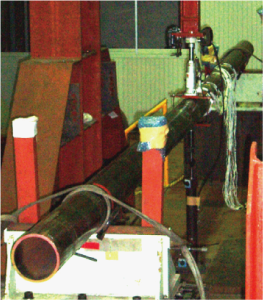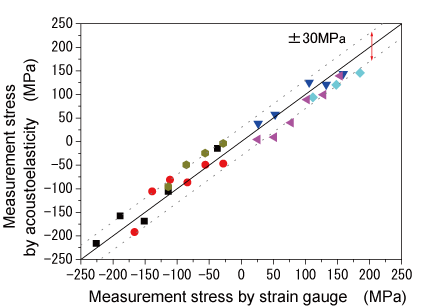| Vol.1 No.3 |
||
| Vol.1, No.4, NT18
|
||
Actual Stress and Thickness Measurement for Steel Pipes Using Electro-magnetic Acoustic Transducer |
||
| Nichizo Tech Inc. and Osaka University | ||
KEYWORDS: |
||
| 1. Technical summary | ||
| Classification (I: Inspection, II: Repair, III: Replacement, IV: Preventive Maintenance, V: Others) | ||
Actual stress and thickness for steel pipes are obtained at the same time without peering coat of paint by using measurement values from a newly-developed electro-magnetic acoustic transducer. This method has already applied to steel construction industries. (1) High-precision wave velocity measurements by the resonance spectrum |
||
|
||
| Fig.1 Resonance Spectrum | ||
.png) Fig.2 Electro-magnetic acoustic transducer | ||
(2) Investigation of acousto-elastic stress measurement by the loading experiment |
||
 Fig.3 Loading experiment of steel pipe |
||
 Fig.4 Comparison of measurement stress by strain gauge and acousto-elasticity |
||
| 2. Scope | ||
(1) Components (2) Materials |
||
| 3. Features | ||
(1) Actual stress and thickness for steel pipes are obtained at the same time without peering coat of paint by using an electro-magnetic acoustic transducer (EMAT). High-precision wave velocity measurements by the resonance spectrum are possible for each pipe material and an appropriate calibration of wave velocity before stress and thickness measurements is necessary. (2) Measurement type is as follows: a) actual stress and thickness measurements at the same time(3) Principles of thickness measurement Resonance formula for thickness measurement is; fn=nV/2dwhere, fn: frequency,V: wave velocity,d: thickness,n: order of resonant modes. Wave velocity is determined by using test piece for calibration. When actual stress measurement is needed, wave velocity along principle stress direction is measured and actual stress is obtained from acoustic birefringence by using a relation of acousto-elasticity, because acoustic birefringence does not affect thickness. (4) This method is possible to measure whole actual stress in a structural component, including dead-load and restraint stress under various boundary conditions. Elastic-plastic stress would be measured by this method in the future. |
||
| 4. Examples of Application | ||
This technique has been applied to stress measurement of various steel pipes in Japan. For example, differential settlement of a buried steel pipe was carried out.
.png) Fig.5 Measurement of the buried steel pipe (Location at 306.8 degree is measured because weld seam is located on the longitudinal line at 315 degree.) .png) Fig.6 Distribution of axial stress at each angle This method has a merit to apply to various support structures and pipings at outdoors in nuclear power plants, because hybrid measurement of thickness and actual stress is possible with paint coating of structures. Evaluation of actual stress change due to wall thinning or crack propagation and the measured hybrid information is expected to use for an appropriate and rational standard of maintenance in the future.
|
||
| 5. Reference | ||
| [1] K. Mitani, M. Mochizuki and M. Toyoda, “Study on Thickness and Actual Stress Measurement of Steel Structures Using Electromagnetic Acoustic Transducer,” Proceedings of the 2007 ASME Pressure Vessels and Piping Conference, San Antonio, USA, PVP2007-26460 (2007). [2] K. Mitani, M. Mochizuki and M. Toyoda, “Hybrid Inspection of Thickness and Stress Conditions in Piping,” Proceedings of Joint Meeting on Inspection, Evaluation and Maintenance, (in Japanese), Tokyo, Japan, pp. 45-48 (2008). |
||
| 6. Contact | ||
| Japan Society of Maintenology (ejam@jsm.or.jp) | ||






.png)
(s).png)